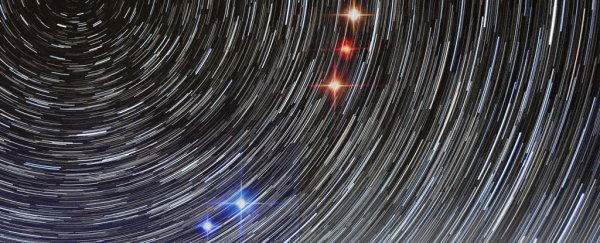After taking new radio observations, astronomers have ruled out a leading explanation for the cyclic nature of a particularly curious repeating space signal.
The signal in question is FRB 20180916B, which repeats with a 16.35-day periodicity. According to existing models, this could result from interactions between closely orbiting stars; however, the new detections - which include fast radio burst (FRB) observations at the lowest frequencies yet - do not make sense for such a binary system.
"Strong stellar winds from the companion of the fast radio burst source were expected to let most blue, short-wavelength radio light escape the system. But the redder long-wavelength radio should be blocked more, or even completely," said astrophysicist Inés Pastor-Marazuela of the University of Amsterdam and ASTRON in the Netherlands.
"Existing binary-wind models predicted the bursts should shine only in blue, or at least last much longer there. But we saw two days of bluer radio bursts, followed by three days of redder radio bursts. We rule out the original models now - something else must be going on."
Fast radio bursts are one of the most fascinating mysteries in the cosmos. They're extremely short bursts of very powerful short-wavelength radio waves - as in, just milliseconds in duration, and discharging as much energy as 500 million Suns in that time. Most of the FRB sources we've detected have only been seen once; this makes them unpredictable and hard to study.
A few FRB sources have been detected repeating, although most have done so erratically. FRB 20180916B is one of the two exceptions found repeating on a cycle, which makes it an excellent case for learning more about these mysterious events.
Last year, we also got a major lead on what could be causing FRBs - the first such signal detected coming from within the Milky Way. It was spat out by a magnetar, a type of neutron star with an insanely powerful magnetic field.
But that doesn't mean the case is entirely solved. We don't know why some FRBs repeat, and others don't, for instance - and why, for the repeating FRBs, periodicity has only been detected rarely.
When FRB 20180916B was found to repeat on a cycle, one of the leading explanations was that the neutron star emitting the burst was in a binary system with a 16.35-day orbit. If this were the case, then lower-frequency, longer radio wavelengths should be altered by the charged wind of particles surrounding the binary.
Pastor-Marazuela and her colleagues used two telescopes to make simultaneous observations of the FRB - the Low Frequency Array (LOFAR) radio telescope, and the Westerbork Synthesis Radio Telescope, both headquartered in the Netherlands. When they analyzed the data, they found redder wavelengths in the LOFAR data - meaning that binary winds could not be present to block them.
Nor, for that matter, could other low-frequency absorbing or scattering mechanisms, such as dense electron clouds.
"The fact that some fast radio bursts live in clean environments, relatively unobscured by any dense electron mist in the host galaxy, is very exciting," said astronomer Liam Connor of the University of Amsterdam and ASTRON.
"Such bare fast radio bursts will allow us to hunt down the elusive baryonic matter that remains unaccounted for in the Universe."
So if the binary explanation is ruled out, what could be causing the periodicity? Well, it's still not aliens, sorry.
One explanation suggested last year involves a single object, such as a rotating magnetar or pulsar. This was thought to be a poorer fit for the data than binary wind of charged particles, since those objects have a wobbling rotation that produces periodicity, and none are known to wobble that slowly.
But with the binary wind off the table, thanks to the LOFAR and Westerbork observations, a slowly wobbling magnetar is back on it. And this suggests we still have quite a bit to learn about both magnetars and FRBs.
"An isolated, slowly rotating magnetar best explains the behavior we discovered," Pastor-Marazuela said.
"It feels a lot like being a detective - our observations have considerably narrowed down which fast radio burst models can work."
The research has been published in Nature.
